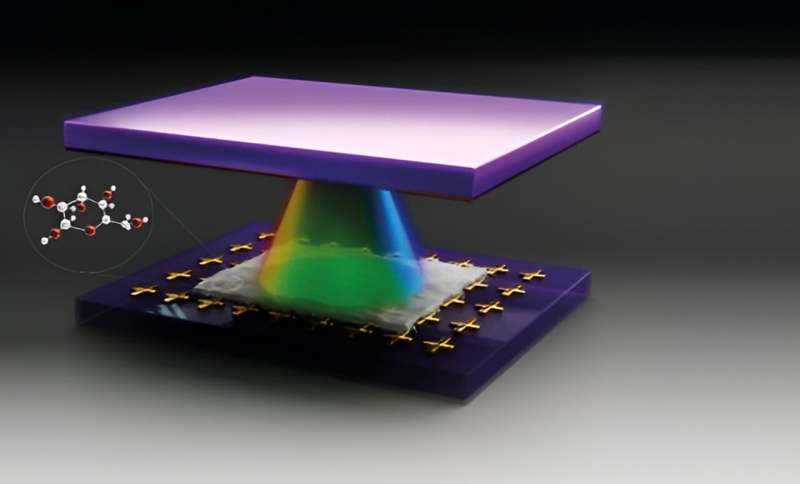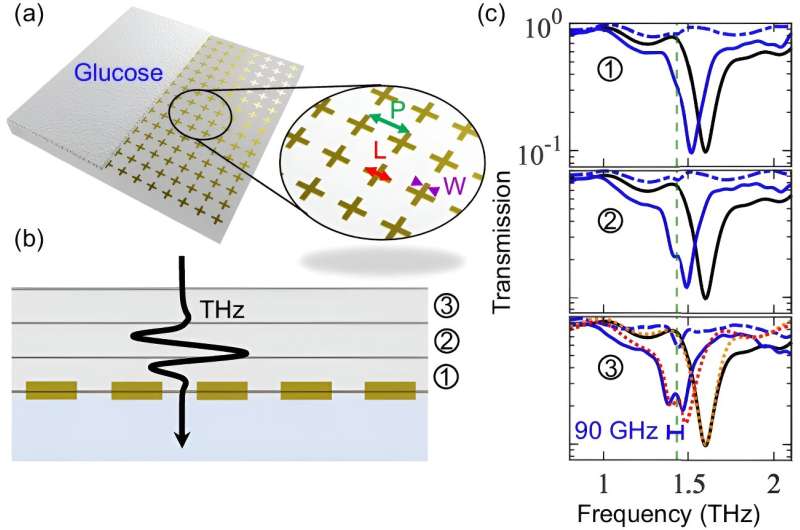This article has been reviewed according to Science X's editorial process and policies. Editors have highlighted the following attributes while ensuring the content's credibility:
fact-checked
peer-reviewed publication
trusted source
proofread
Q&A: New method confines light inside an organic material to form a hybrid quantum state

A team of international scientists led by the University of Ottawa have gone back to the kitchen cupboard to create a recipe that combines organic material and light to create quantum states.
Professor Jean-Michel Ménard, leader of the Ultrafast Terahertz Spectroscopy group at the Faculty of Science, coordinated with Dr. Claudiu Genes at the Max Planck Institute for the Science of Light (Germany), and with Iridian Spectral Technologies (Ottawa) to design a device which can efficiently modify properties of materials using the quantum superposition with light.
The team designed a two-dimensional planar resonator—known as a metasurface—that captured light. Using a spray coating technique, they then deposited a thin glucose layer on that metasurface to induce a strong interaction between light and glucose molecules in sugar.
Their concept brings researchers closer to being technologically able to harvest some of the unique properties of quantum systems falling in a hybrid state of both light and matter.
Faculty of Science professors Ksenia Dolgaleva and Robert Boyd contributed to the work alongside Professor Menard, the lead author, who discusses the findings published in Nature Communications.
What did you set out to do and what did you find?
We present an innovative and efficient technique for synthesizing quantum organic materials by combining light and matter. When light in the far-infrared region—at terahertz (THz) frequencies—become strapped within an organic material, it can merge with molecules, resulting in a quantum state that exhibits unique properties which are of growing interest because of their potential application in modifying the physical and chemical properties of matter. These intriguing states only arise under specific conditions.
Our team identified these critical conditions and created a photonic trap or device to effectively confine light within a small volume space during a substantial amount of time. This trap enables a strong coupling regime to be established between light and a molecular ensemble.
Unlike previous approaches that relied on optical cavities made of two facing mirrors, we instead designed and tested a two-dimensional planar resonator known as a metasurface. This metasurface effectively allows optical confinement within a planar geometry, opening new practical avenues to explore the quantum regime of strong light-matter interactions.
Finally, we combined metasurfaces with traditional cavity geometries to form hybrid cavity architectures and observe an enhancement of the coupling strength between light and matter. These results are demonstrated with glucose, an organic compound with properties useful to the fields of biology and medicine.

Why use THz light and sugar?
Terahertz light is particularly interesting because it can induce vibrations in many molecules, including glucose molecules in sugar. The energy of vibration of molecules is intricately connected to their properties including their ability to engage in chemical reactions with other molecules.
Therefore, by designing platforms enabling a strong coupling between terahertz light and the vibration of molecules, which are fundamental building blocks of organic substances, we have the potential to change their properties to potentially gain control over mechanisms at the foundation of life.
What did you ultimately find through your research?
We discovered efficient approaches to couple terahertz light and matter. The most promising concept is based on a structured metallic surface, the metasurface, incorporated into the design of a photonic cavity. As a result, light becomes doubly trapped and remains tightly confined within the device.
Our robust plug-and-play platform allows potentially many organic materials to be inserted inside this device to create quantum systems with new properties. This is due to the fact that no precise alignment of the device is required to trap the light as this critical condition is mostly fulfilled by the geometry of the metasurfaces metallic pattern. Interestingly, since scalable fabrication techniques exist to fabricate metasurfaces interacting with terahertz light, we believe that these devices could be used relatively soon for real-life applications of quantum-enhanced chemical reactions.
What kind of impact can this research have?
These results bring us closer to being technologically able to harvest some of the unique properties of quantum systems consisting of a hybridized state of light and matter.
By performing a systematic theoretical and experimental study of different types of photonic resonators, we discovered some novel photonic resonator designs that can create a quantum superposition between a molecular material, glucose, and light in a specific region of the far-infrared spectral window called the terahertz region.
Previous work demonstrated that this hybridization process, when it involves terahertz light, modifies the original physical and chemical properties of the material. For example, the presence of a photonic resonator can change the rate of some chemical reactions involving that material.
In the future, we believe this approach could help regulate some molecular processes, leading to application in medicine for rapid diagnostics and potentially new therapeutic strategies.
More information: Ahmed Jaber et al, Hybrid architectures for terahertz molecular polaritonics, Nature Communications (2024). DOI: 10.1038/s41467-024-48764-6
Journal information: Nature Communications
Provided by University of Ottawa



















